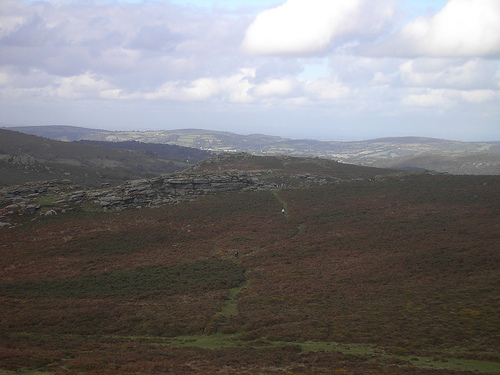The Dartmoor National Park, located in Devon, in southwest England, spans 368 sq miles and is characterised by its rugged moors, granite tors and windswept valleys. Whilst many people enjoy the outdoor life and activities around the moors, a more unusual museum giving insight into life inside is the Dartmoor Prison Museum, at Princetown.
 The small town of Princetown lies at 1300ft above sea level – making it the highest town on Dartmoor – and is famous for being the location of Dartmoor Prison. The idea for the prison was first conceived in 1805 and the building has become renowned for dominating the landscape with its stark and bleak appearance. Made of local granite, sourced nearby at Herne Hole Quarry, the construction began in 1806 and took three years to complete. The first intake of prisoners – French prisoners captured during the Napoleonic wars – arrived to take up residence in 1809.
The small town of Princetown lies at 1300ft above sea level – making it the highest town on Dartmoor – and is famous for being the location of Dartmoor Prison. The idea for the prison was first conceived in 1805 and the building has become renowned for dominating the landscape with its stark and bleak appearance. Made of local granite, sourced nearby at Herne Hole Quarry, the construction began in 1806 and took three years to complete. The first intake of prisoners – French prisoners captured during the Napoleonic wars – arrived to take up residence in 1809.
The Dartmoor Prison Museum, open since 1996, is located close by and was originally a dairy, responsible for producing butter and milk for the prison.
Dartmoor Museum Exhibits
The Dartmoor Museum houses several rooms of intriguing exhibits, which provide an interesting insight into life over the years for both prisoners and staff in the prison. Photographs, mannequins and other exhibits are used to map out the way in which the prison uniform has changed over the years. The permissible hairstyles of prisoners has been through various incarnations too and you can see the different variations that existed.
 Prison officers have always been issued with restraints and weapons, but some of the items used in the past are quite an eye-opener. The cat o’nine tails in particular has a horrifying description of how it was made in order to cause long-term scarring on those whom it was inflicted. However, when you learn that the building has been home to some notorious prisoners over the years, like John George Haigh and Frank Mitchell, the need to have these kinds of items at hand becomes clearer.
Prison officers have always been issued with restraints and weapons, but some of the items used in the past are quite an eye-opener. The cat o’nine tails in particular has a horrifying description of how it was made in order to cause long-term scarring on those whom it was inflicted. However, when you learn that the building has been home to some notorious prisoners over the years, like John George Haigh and Frank Mitchell, the need to have these kinds of items at hand becomes clearer.
Whilst inside, many of the prisoners developed a creative streak, illegally making a wide range of items. Some of the unusual pieces are on display, such as hand sculpted scenes carved out of meat bones. Although some of the exhibits are a bit hard-hitting, children are catered for and there’s a quiz sheet available that they can take around with them, with a small prize on offer for achieving 15 correct answers.
 In addition to traveling into the past with information and exhibits about the history and life of the prison, visitors are brought up-to-date with a DVD showing Dartmoor Prison as it is today. It includes input from both staff and prisoners and provides a moving insight into the reality of prison life.
In addition to traveling into the past with information and exhibits about the history and life of the prison, visitors are brought up-to-date with a DVD showing Dartmoor Prison as it is today. It includes input from both staff and prisoners and provides a moving insight into the reality of prison life.
As you’d expect at a tourist attraction, the museum shop sells a selection of the usual touristy items, but there’s one other rather unusual item on offer too. If you like the idea of owning a piece of Dartmoor prison history, then you could purchase a genuine cell door – they’re for sale for £50 each.
The Dartmoor Prison Museum is open daily most of the year and there’s free parking available.


Comments